|

Brisk Ebullience
LAWRENCE BUDMEN sends a second report
from this summer's Tanglewood Festival
Musical birthday celebrations were in the spotlight as July seamlessly made room for August amidst the majestic mountains and rain-soaked greenery of the Berkshires at Tanglewood, the Boston Symphony Orchestra's summer festival, near Lenox, Massachusetts, USA. On 31 July 2009 the BSO marked the 75th birthday of Spanish-born conductor Rafael Frühbeck de Burgos, an annual guest with the ensemble both in Boston and Tanglewood. The music of Beethoven, long a Frühbeck de Burgos specialty, shared the program with colorful French showpieces by Debussy and Ravel.
Frühbeck de Burgos remains the most consummate, totally reliable of conductors. His ability to inspire second and third tier orchestras to new heights can be astounding. With a major symphonic ensemble like the BSO, his performances frequently channel fresh light to familiar scores, bringing transparency to instrumental textures often overlooked in routine performances. (This conductor's electrifying version of Beethoven's 5th Symphony last summer -- 2008 -- at Tanglewood was one such revelation.) With the greatest respect to this patrician maestro, Russian violinist Vadim Repin may well have dominated the evening with a remarkable, visionary interpretation of Beethoven's Violin Concerto in D Major, Op 6.
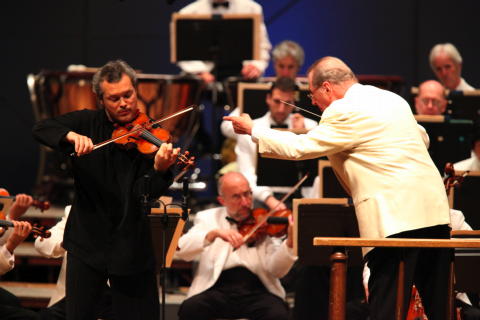
Vadim Repin and Rafael Frühbeck de Burgos with members of the Boston Symphony Orchestra. Photo © 2009 Hilary Scott
|
Repin was an extraordinary technician, a virtuoso of awesome abilities while still a teenager. Subsequent performances tended to emphasize flashy razzle dazzle over musical subtlety. Now in his late thirties, Repin has become a mature artist, a musician of deep introspection. He displayed silken tone, nobility of phrase and utterance. Repin played Beethoven's magnum violin opus as the eloquent masterwork that it is, supporting an unending lyrical line in the Larghetto with the softest of dynamics, reduced to a mere thread of tone. The bouncy lightness and verve of the Rondo: Allegro finale was irresistible, the violinist essaying the double stops with disarming brio. Repin's mastery of Beethoven's magisterial writing gave total emphasis to the music rather than treating it as a vehicle for shallow display -- great artistry indeed! Frühbeck de Burgos and the BSO (in top form) offered flawless support. The large audience in the Koussevitzky Music Shed gave the performance rapt attention (with nary a cough to be heard). Clearly aware that this was music making of the most extraordinary variety, the throng rose as one in tribute to soloist and conductor.
Frühbeck de Burgos' view of Debussy's La Mer was pointed and taut, restoring modernism to the score obscured in more sugar coated interpretations. So ferocious were the orchestral climaxes that one could literally feel the waves and wind gusts that Debussy so vividly portrayed. Sensuous strings evoked intoxicating impressionistic perfumes. Frühbeck de Burgos' lush treatment of Ravel's Daphnis et Chloe Suite No 2 was dominated by exquisite wind playing and whip crackling brass and percussion. Principal flutist Elizabeth Rowe exuded ravishing elegance and a plethora of pure, true tone in her many solo opportunities. Frühbeck de Burgos whipped up the final Dance generale to a fever pitch -- an exciting climax to a tour de force performance.
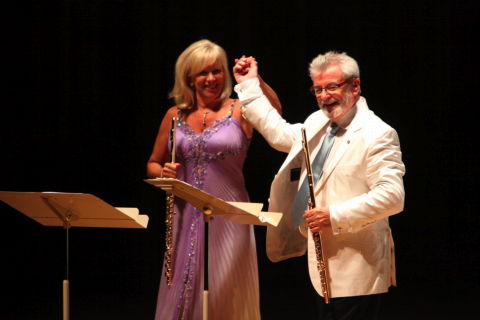
Jeanne and James Galway at Tanglewood. Photo © 2009 Hilary Scott
|
The following evening (1 August) brought a celebration of Sir James Galway's 75th birthday and 26th wedding anniversary. (Galway's wife Lady Jeanne Galway is a formidable flutist in her own right.) Leonard Slatkin, newly ensconced as Music Director of the Detroit Symphony, brought experienced command to the celebratory proceedings.
Subtly evoking the mist of impressionism that is Debussy's Prelude to the Afternoon of a Faun, Slatkin was aided again by the indispensible Ms Rowe, whose tonal radiance and precision of musical execution exuded the magic inherent in the work. Aaron Copland's 1944 ballet score Appalachian Spring has long been a Slatkin specialty. The conductor chose Copland's 1954 large scale orchestration of the complete ballet rather than the familiar, abbreviated suite. (In its original form, the Martha Graham inspired work was scored for thirteen instruments.) Copland's complete score is darker, channeling greater emotional depth and structural grandeur. Marvelously transmitting the work's true Americana spirit, Slatkin drew a virtuosic, subtly detailed performance from the Boston ensemble. (This orchestra has a long history with Copland and this piece in particular. Koussevitzky led the BSO in the second live performance of the Appalachian Spring Suite on 25 October 1945, introducing the music to Tanglewood on 28 July 1946. In the late 1950s Copland conducted his first recording of the suite with the BSO.)
The evening's second half was all Galway. Specially commissioned for the occasion, Swing Song by Derek Bermel is scored for solo flute, flute ensemble and percussion. For this performance, forty flute and piccolo players joined Galway. The entire flute contingent of the BSO, Tanglewood Music Center Orchestra, Boston University-Tanglewood Institute Young Artists Orchestra (the Tanglewood affiliated high school level program) plus young middle school instrumentalists from Massachusetts and Connecticut area schools joined Galway for Bermel's charming pastiche with a decidedly Latin beat and flashy solo leaps (for the evening's honoree). Slatkin led this flute amalgamation with breezy efficiency. This score should provide great fun for attendees at flute conventions for years to come.
No one brings more élan to Mozart than Galway and the master's performance of the Flute Concerto No 2 in D, K314, was appropriately lithe and stylish. Galway's exquisite rendering of the Andante reached another level; the zippy Rondo: Allegretto finale was rendered with appropriate verve. Slatkin had the reduced Boston ensemble playing with feathery, brisk ebullience.
Then came nearly an hour of encores and guest appearances. Two of Galway's fellow Irish musicians provided much pleasure -- pianist Michael McHale in a poetic nocturne by John Field and Anthony Kearns, a pop-inflected lyric tenor. The Miami-based Cuban timba band Tiempo Libre, which recorded an album with Galway in 2008, brought its uniquely Latin pop-infused energy to Galway's performance of the slow movement of the famous Suite for Flute and Jazz Piano by Claude Bolling. Recalling his 1980s recording and concert tours with the late Henry Mancini, Galway produced jazzy insouciance in the theme from The Pink Panther. Joined by his wife Lady Jeanne Galway, the pair collaborated on Mancini's exuberant arrangement of Meredith Wilson's 76 Trombones -- great fun. The duo also offered a lively romp through Mozart's Turkish Rondo. Galway concluded the evening with his theme song -- a sentimental version of Danny Boy, played with gorgeous tone and patrician artistry. Finally Slatkin led the audience in singing Happy Birthday to the evening's honoree. (This will be the only time this writer sang with the Boston Symphony Orchestra.) The entire evening was a joyous, celebratory tribute to a great musician and larger than life artistic personality.
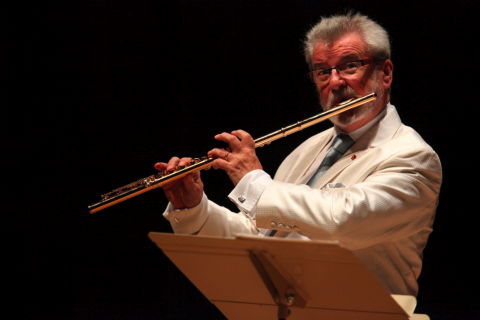
James Galway playing at Tanglewood's Seiji Ozawa Hall on 29 July. Photo © 2009 Hilary Scott
|
Two nights earlier (30 July) Galway presented a recital in the wood-paneled intimacy of the Florence Gould Auditorium of Seiji Ozawa Hall -- an evening of salon delights. This virtuoso's effervescent personality can easily mask his instrumental mastery. Galway flawlessly essays technical pyrotechnics (eg triple tonguing and rapid scales) that most flutists would not dare attempt. Whether in Philippe Gaubert's enchanting Sonata No 3 and Nocturne and Allegro Scherzando or the disarming simplicity of Cecile Chaminade's Concertino and Debussy's Clair de lune, the beauty, elegance and virtuosity of Galway's playing was in a class of its own. Phillip Moll was the skillful, rhapsodic collaborator at the keyboard. Lady Galway joined her husband for the wild thematic variations of Franz and Karl Doppler's Rigoletto Fantasy for two flutes. Verdi may have turned over in his grave but the audience reveled in this dazzling display of fireworks, an irrisistible combination of showbiz flash and peerless musicianship. Galway concluded this delightful program with a triple dose of bravura: an unlikely transcription of Antonio Bazzini's rapid fire violin showpiece Dance of the Goblins, Claude-Paul Taffanel's Grand Fantasy on themes from Thomas' Mignon (a super tour de force) and (as encore) the flute version of Rimsky-Korsakov's Flight of the Bumble Bee. In the latter, Galway promised and delivered 'thousands of notes in one minute'. To Sir James, thank you for fifty years of priceless music making. Happy Birthday and many more!
The impressive Danish conductor Thomas Dausgaard commanded the Boston Symphony podium for the matinée performance on 2 August -- the Serge and Olga Koussevitzky Memorial Concert. Principal Conductor of the Danish National Symphony Orchestra and the Swedish Chamber Orchestra, Dausgaard has a strong Tanglewood connection. In the early 1990s he was Seiji Ozawa's assistant at the BSO and conducted at the summer festival in the Berkshires.
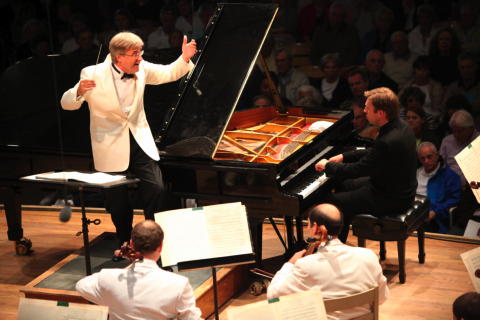
Leif Ove Andsnes with Thomas Dausgaard and members of the Boston Symphony Orchestra at Tanglewood on 2 August. Photo © 2009 Hilary Scott
|
Now a globetrotting maestro with numerous recordings to his credit, Dausgaard is noted for his Beethoven interpretations. (He has recorded Beethoven's symphonies and other orchestral works with his Swedish ensemble.) His strong, forthright approach to the master from Bonn's output shone resplendently in a perfect, model collaboration for Leif Ove Andsnes' admirably restrained, introspective performance of the Piano Concerto No 3 in C minor, Op 37. One of the most interesting keyboard artists on today's concert stages, Andsnes approached the familiar score with delicately nuanced musicality that avoided bombast. The lyrical poetry of the Largo and quirky, rhythmic lift of the final Rondo: Allegro, combined with Andsnes' flawless finger work, capped a performance of exceptional intimacy and artistic individuality. Andsnes, a former Gilmore Award winner, exuded artistry on the highest level.
Dausgaard drew splendid orchestral firepower from the BSO in Rachmaninoff's Symphony No 2 in E minor, Op 27. The coolness of his Nordic temperament (and minimal instrumental rubato) robbed the Adagio of romantic passion. Nevertheless the surging energy, beautiful orchestral playing and effective climactic flourish were not to be denied. All that was needed was greater heart on the sleeve immediacy. Dausgaard certainly emerged a tremendously gifted and potent conductor that this listener looks forward to hearing in the future.
The terrifically talented fellows of the Tanglewood Music Center Orchestra took center stage on 3 August for an ambitious Stravinsky program that Rafael Frühbeck de Burgos shared with conducting fellow Ryan McAdams. Performed in its entirety with the vocal parts, the ballet score Pulcinella (1920) was a package of elegant delights, beautifully and gracefully articulated. Vivacious, light and airy, Frühbeck de Burgos' performance reminded the listener of Otto Klemperer's classic recording of the suite. Supposedly based on themes by Pergolesi, Stravinsky's neo-classical score was caressed with Mozartean elegance and vivid instrumental colors.
In the Gavotte and variations, the wind section played without a conductor, like a chamber music group. (Frühbeck de Burgos simply gave them a downbeat and let the group play.) The sweetness and agility of that eight-member wind contingent was striking. Excellent vocal soloists were led by the pure, beautiful high soprano of Allison Angelo. Alex Richardson revealed a strong, vocally secure lyric tenor and Alan Dunbar exuded confidence with a well-schooled light baritone. The wonderfully balanced trio of the minuet was a treat to hear. Eli Maurer's flashy trumpet headlined the bright, piercing Allegro assai finale. A winning performance!
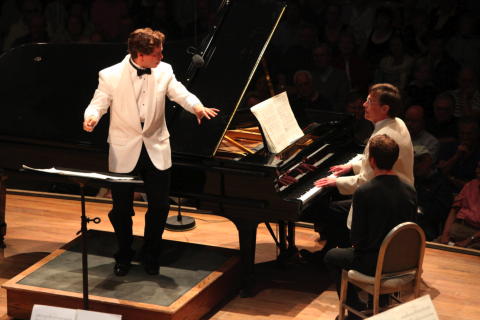
Peter Serkin with Ryan McAdams on 3 August. Photo © 2009 Hilary Scott
|
The Concerto for Piano and Winds (1923-24) is an astringent reinvention of Bach, rich in craggy counterpoint, acid harmonies and allusions to the jazz age of the 1920s. In the daunting solo role, Peter Serkin was sensational, exhibiting rapid digital dexterity, virtuosity and the intelligence and musicality to find musical logic in Stravinsky's fractured meters and acerbic thematic invention. The work's knuckle-breaking demands held no terrors for Serkin, one of the truly remarkable artists of our age who is capable of playing the most technically impossible scores. Conducting fellow Ryan McAdams, music director of the New York Youth Symphony, contributed vitality and electricity on the podium, drawing stunning playing from the wind and brass ensemble.
Frühbeck de Burgos molded the Suite from The Firebird (1919 version) with eloquence and finesse. From the ruminative opening to the explosive firepower of Kashchei's Infernal Dance and the lush strings of the Lullaby, this Firebird was propelled with balletic momentum and drama. The flute solos by Katrina Walter, a member of the Miami-based New World Symphony, were breathtakingly accurate, pure in tone and aristocratically shaped. Here was a Firebird that any professional orchestra would be proud of and many could not surpass! The Tanglewood fellows gave splendid accounts of three difficult Stravinsky scores -- a wonderful cornucopia of the many faces of a twentieth century master.
At the intimate auditorium of the Clark Art Institute in colonial Williamstown, the Ying String Quartet offered a superb evening of chamber music on 4 August 2009. Warmth of tone and precision of ensemble mark this outstanding group which began its professional concert career in the early 1990s with a residency in the farm town of Jesup, Iowa, near the community where Dvorák wrote his American quartet. For this concert Steven Copes, concertmaster of the St Paul Chamber Orchestra, joined violinist Janet Ying, violist Phillip Ying and cellist David Ying.
Mendelssohn's String Quartet in E flat, Op 12 (1829) soared with stormy romantic passion. The feathery lightness of the Molto allegro e vivace finale was quintessentially Mendelssohnian. Commissioned by the Ying foursome, the String Quartet No 3 (dedicated to the victims of war) by Lowell Liebermann is a lyrical, agitated, clearly deeply felt score. The solemn conclusion provides an emotional catharsis that stems from the work's serious, inspirational subject matter. Here is a work that is unabashedly tonal, yet artistically and intellectually challenging.
The quartet was joined by pianist Adam Neiman for an incendiary traversal of Brahms' Quartet in F minor for Piano and Strings, Op 34. Neiman's spellbinding bravura ignited a performance of surpassing brilliance. The burnished glow of the opening Allegro non troppo set the stage for the combustion of the final two movements. Neiman's stunning keyboard theatrics fused with the quartet's flawless ensemble playing for a taut, exciting, impassioned rendition of a chamber music classic.
Copyright © 11 October 2009
Lawrence Budmen,
Miami Beach, USA

|

